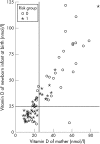High prevalence of vitamin D deficiency in newborn infants of high-risk mothers
- PMID: 17715438
- PMCID: PMC2084031
- DOI: 10.1136/adc.2006.105577
High prevalence of vitamin D deficiency in newborn infants of high-risk mothers
Erratum in
- Arch Dis Child. 2007 Nov;92(11):1049
Abstract
Objective: To determine the prevalence of vitamin D deficiency in newborn infants of mothers at risk of vitamin D deficiency because of dark skin or the wearing of concealing clothes (such as a veil) compared with a group presumed not to be at risk. A second aim was to correlate these newborn infants' vitamin D concentrations with biochemical parameters of vitamin D metabolism and bone turnover at birth.
Design: A prospective study conducted between April 2004 and February 2006 including women delivering during this period and their newborn infants.
Setting: The outpatient clinic of the obstetrics department, Sint Franciscus Gasthuis, Rotterdam, the Netherlands.
Patients: Eighty seven newborn infants of healthy mothers with either dark skin and/or concealing clothing (risk group) or light skin (control group).
Results: We found a significant difference in the prevalence of vitamin D deficiency (25-hydroxyvitamin D(3) <25 nmol/l) between newborn infants of mothers at risk and those of mothers in the control group (63.3% vs 15.8%; p<0.001). Mean alkaline phosphatase concentrations were significantly higher in the at risk group.
Conclusions: Newborn infants of mothers with dark skin or wearing concealing clothes are at great risk of vitamin D deficiency at birth. The clinical implications are unknown. Further research is necessary to determine the long-term consequences of maternal and neonatal vitamin D deficiency so that guidelines on vitamin D supplementation during pregnancy can be issued.
Conflict of interest statement
Competing interests: None.
Comment in
-
Mother-child vitamin D deficiency: an international perspective.Arch Dis Child. 2007 Sep;92(9):737-40. doi: 10.1136/adc.2007.122689. Arch Dis Child. 2007. PMID: 17715433 Free PMC article.
-
Vitamin D in pregnancy: an old problem still to be solved?Arch Dis Child. 2007 Sep;92(9):740-1. doi: 10.1136/adc.2007.120774. Arch Dis Child. 2007. PMID: 17715434 Free PMC article.
-
A possible re-emergence of osteomalacia in women and severe hypovitaminosis D in newborn infants in France.Arch Dis Child. 2008 Apr;93(4):354. doi: 10.1136/adc.2007.135004. Arch Dis Child. 2008. PMID: 18356392 No abstract available.
References
-
- Prentice A. Micronutrients and the bone mineral content of the mother, fetus and newborn. J Nutr 20031331693S–9S. - PubMed
-
- Specker B. Vitamin D requirements during pregnancy. Am J Clin Nutr 200480(Suppl)1740–47S. - PubMed
-
- Namgung R, Tsang R C. Factors affecting newborn bone mineral content: in utero effects on newborn bone mineralization. Proc Nutr Soc 20005955–63. - PubMed
MeSH terms
Substances
LinkOut - more resources
Full Text Sources
Medical
Miscellaneous

